Rhinoplasty: Nose Reshaping in Harley Street, London
The most common reasons people seek nose surgery is for reshaping of the nose, a high dorsal hump, lack of tip definition, a large or wide size of their nose. Dr De Silva believes that refinement in surgery is the key to a natural-looking result where the surgical technique is tailored to the individual.
FACELIFT SURGERY IN HARLEY STREET
What is Rhinoplasty?
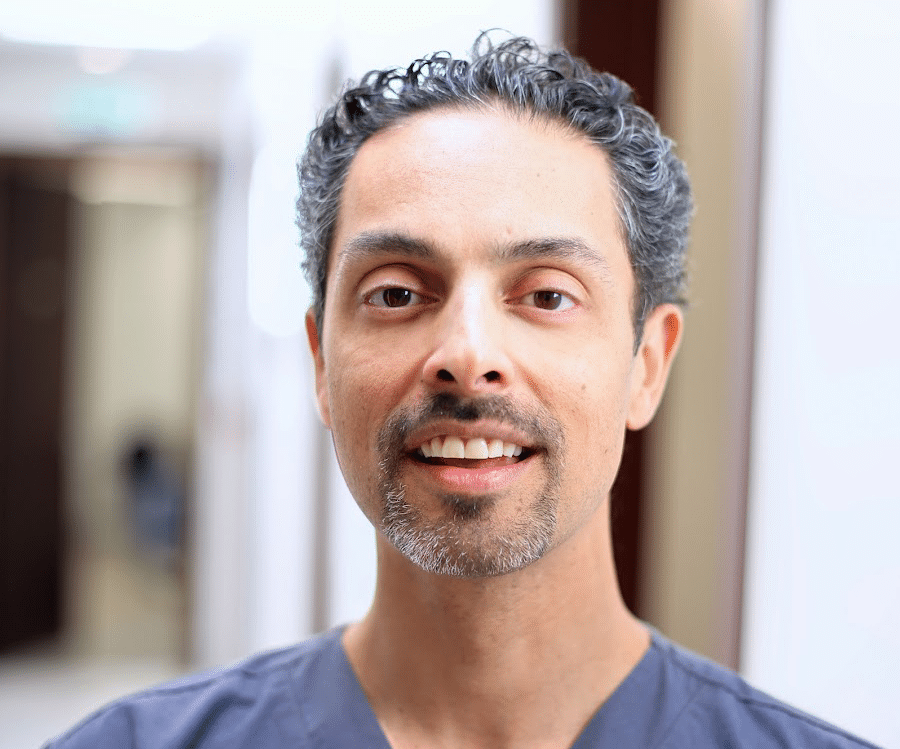
Dr. Julian De Silva, is a renowned and accomplished facial plastic surgeon, has dedicated his career to the art and science of enhancing facial aesthetics. Among his expertise lies a profound understanding of rhinoplasty, a transformative surgical procedure that focuses on reshaping and refining the nose. Dr. De Silva’s commitment to precision and innovation in facial surgery has positioned him as a leading authority in the field.
Rhinoplasty, often referred to as a “nose job,” goes beyond mere cosmetic alterations; it involves a delicate balance of artistic vision and surgical skill to achieve harmonious facial proportions. In this intricate procedure, Dr. Julian De Silva employs advanced techniques to address both aesthetic concerns and functional aspects of the nose, ensuring that patients not only achieve their desired look but also experience improved breathing and overall facial balance.
As we delve into the realm of rhinoplasty through Dr. De Silva’s expertise, we embark on a journey that explores the intricacies of this transformative surgery, shedding light on its nuances, benefits, and the transformative impact it can have on an individual’s facial harmony and self-confidence.
As the nose forms the very centre of your face it is also key to facial harmony and balance. Having a nose that is out of place catches our attention when we look at ourselves and people’s faces. This can result in patients feeling self-conscious and over time can affect how we feel about ourselves.
Our thoughts about our own appearance can have an important influence on all aspects of our lives. Dr De Silva has helped many thousands of patients by improving their facial balance.
After surgery, your nose can blend with the rest of your face, reducing those feelings of being self-conscious and enabling you to just get on with life. The detail around the nose is of great importance, as subtle changes of even less than half a millimetre can be discernible.
Why Choose Dr De Silva in Harley Street, London ?
Dr De Silva is a widely credited and celebrated facial plastic surgeon who specialises in the eyes, nose, face and neck areas only, and is known for natural results. Dr De Silva is a widely credited and celebrated facial plastic surgeon who specialises in the eyes, nose, face and neck areas only, and is known for natural results.
“My focus has and always will be to be the very best at what I do, to continually innovate to provide World Class leadership to all my team, all my patients and all my associates. My mission is to help every patient be the very best version of themself with World-Class services, life-long follow up with complimentary facial aesthetic procedures.”
In a world of increasing complexity and misinformation, his passion has been focused on providing sincere advice, low risk and fast recovery procedures.

Facelift & Facial Only Treatments
By focusing entirely on only facelift & facial cosmetic surgery procedures, Dr De Silva is able to provide the expertise that can only come with specialisation: facelift and neck lift, blepharoplasty, rhinoplasty and chin implants.
Natural Looking Results
Dr De Silva is a believer in the importance of artistry behind cosmetic results and focuses his skills at delivering natural looking results.
Fast Recovery
Dr De Silva has pioneered the advances in technology to speed up recovery with a combination regenerative medicine techniques, Oxygen and LED Therapy.
World Class Expertise
Dr De Silva also teaches other surgeons internationally and has contributed to the development of advanced surgical techniques, laser technology and stitch-less tissue adhesives.
Nose Reshaping Technique And Procedure
Tip Definition:
A sculpted and lifted tip of the nose can be achieved by internal stitches, sculpting of cartilages and cartilage grafts.
Cartilage Support Grafts:
In the past, cartilage reshaping could be imprecise, leading to misshapen results. Now, by using pieces of your own cartilage to assess and correct internal contour irregularities,
Dr De Silva can create more symmetrical results.
Breathing:
Although many patients are focused on the appearance of the nose, rhinoplasty often makes your nose smaller, breathing is important! Often a combination of straightening your septum (cartilage in the middle of nose) and graft material is required to ensure good breathing.
An Ultrasonic Rhinoplasty:
Your surgeon can now cut through bone with extreme precision. This advanced osteotomy technique is highly successful.
It prevents damage to the surrounding blood vessels and tissue while cutting bone, and it may lead to less swelling and bruising. Not necessary for all patients.
Cartilage Suturing:
Previously, lower nose cartilage was trimmed to correct bulbous features. Now, we know that the nose must be properly approached with a combination of trimming and specialised suturing. This dual technique creates better proportions and a more uniform appearance.
Faster healing:
Healing can be enhanced with the use of anti-inflammatory medicine after surgery, this can be particularly important for revision rhinoplasty, ethnic rhinoplasty and patients with thicker skin.
World Class Facial Cosmetic and Plastic Surgery
Rhinoplasty Before & Afters
Dr De Silva has transformed thousands of faces through his unique surgical techniques. Below is a small sample of some of his transformations.
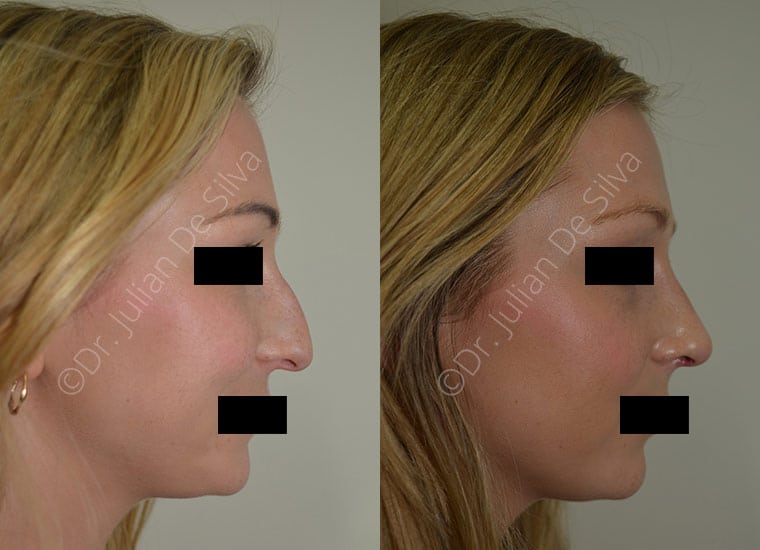
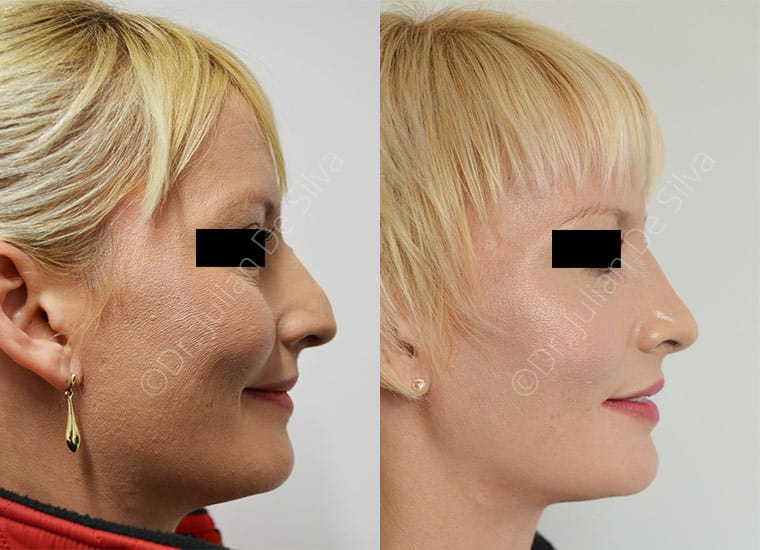
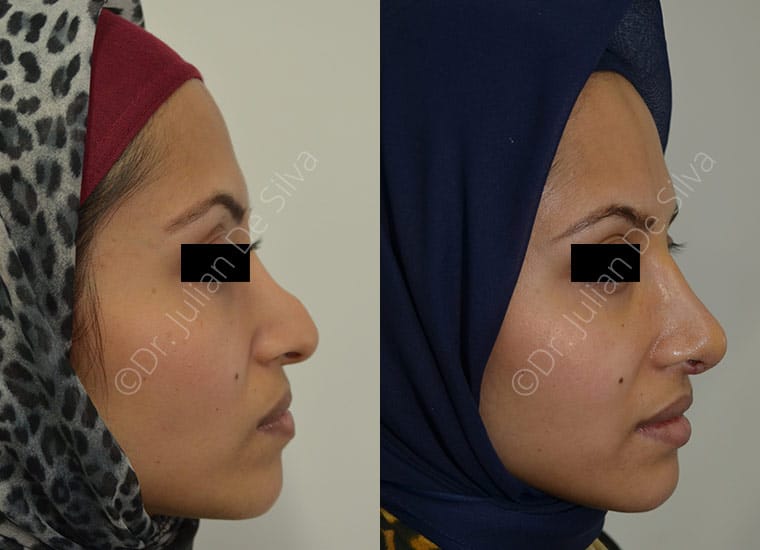
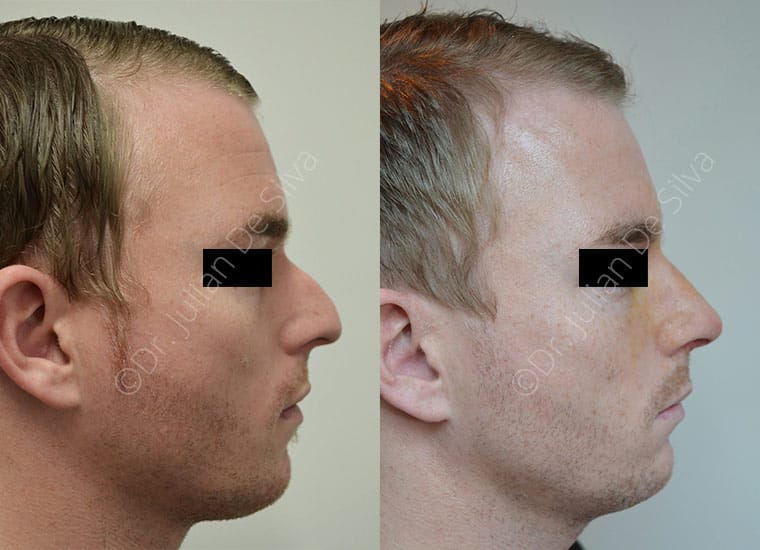
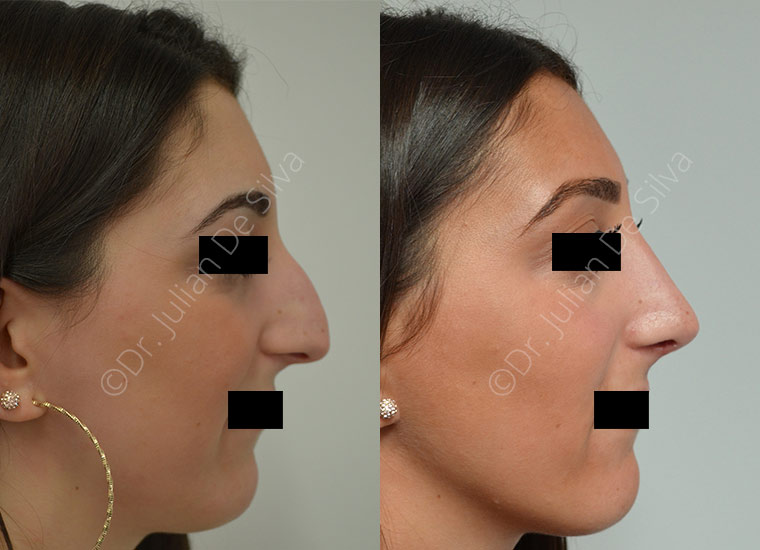
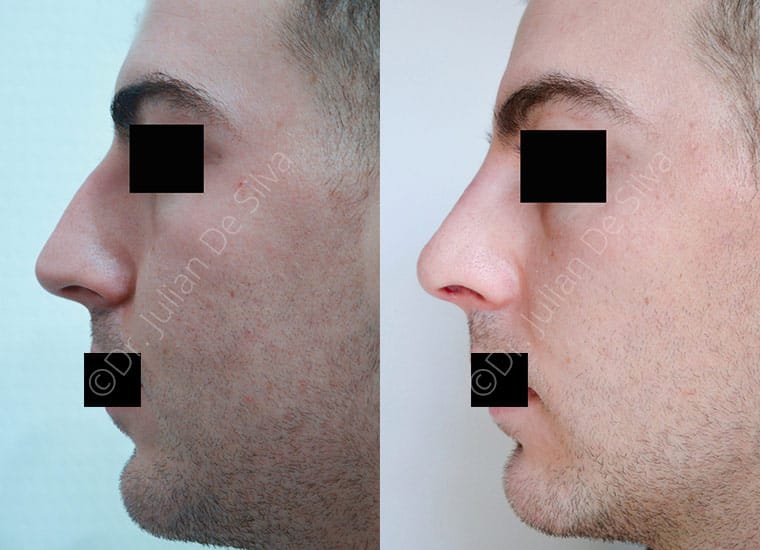
Patient Experiences
All these patients underwent Rhinoplasty with Dr De Silva. We encourage patients to watch one or two videos of patient experiences to have a good understanding of healing and the recovery period. Dr. De Silva and his team will provide support and reassurance during your recovery, we believe that being a well-informed patient is helpful to most patients undergoing Rhinoplasty.
TESTIMONIAL
What our satisfied clients are saying
“I am currently in Dhaka, and I am healing very well. I am extremely happy with the results and it looks so natural that everyone says I look much fresher but no one can put a finger on the reason why. I just wanted to thank you again, and also ask if I can resume taking my Vitamin E and Omega 3 supplements.
Thanks you so much!”
Monjarin
Rhinoplasty
Frequently Asked Questions
I Live Abroad, How Can I Have Surgery?
Dr De Silva has a large number of patients that live overseas. Our specialist team can help you organise a virtual consultation and coordinate your trip to the UK.
You would need to say in the UK for approximately 10days, prior to covid, many patients would fly internationally to London to undergo rhinoplasty before returning to their home country.
We are able to utilise the latest technology to enhance your recovery including oxygen therapy, medications, lymphatic drainage and regenerative medicine.
At What Age Should You Get Rhinoplasty?
Most patients who look to undergo nose reshaping have felt self-conscious about their nose for many years before attending the consultation.
A nose that is out of balance with your face often becomes apparent in teenage years, though many patients take years to look into changing their nose.
Rhinoplasty is most commonly completed in patients aged twenty to forty-five, and Dr De Silva has completed surgery for some teenagers and patients in their 80s. Dr De Silva has had patients travel long distances and internationally for opinions on their nose, sometimes they have been refused surgery by local surgeons.
Often there may be additional factors to consider with increasing age, these can include breathing issues, drooping tip (termed ptosis) and increase irregularity, and these may require additional treatments at the same time to ensure a successful result.
Am I Too Young to Have Rhinoplasty?
Dr De Silva sees many younger patients for nose shaping in their teenage years. Many of these patients have disliked the appearance of their nose for many years before attending a consultation, and some have associated breathing issues and have been teased about their appearance.
Of key importance before considering rhinoplasty is the patient understands the implications of surgery, recovery, and expectations.
Utilising modern surgical techniques are important to ensure a long-lasting natural result. Dr De Silva completes nose reshaping on younger patients only when it is in their best interest and some patients travel long distances to London.
Do I Need to Go to Hospital?
Rhinoplasty is commonly completed in a general hospital with other surgical procedures in a general private hospital. Patients often are concerned about issues with general hospitals such as MRSA and hospital-acquired infection. Dr De Silva has built a custom state of the art facility including a private operating theatre to enable complete specialisation for every patient.
How Much Does Rhinoplasty in London Cost?
When looking for the best rhinoplasty results in London then costs should not be a consideration, but rather focus on the facility, qualification, experience, and technique of your surgeon. Given these considerations, expect to pay anywhere between £5,000 to £15,000 for a nose job in London, UK.
Can Rhinoplasty Be Combined With Other Techniques?
Dr De Silva frequently combines rhinoplasty with other facial procedures to give a natural-looking result and avoid the use of scars associated with conventional techniques:
Contact Details
Call: 020 8748 2860
Email: info@drjuliandesilva.co.uk
Address:
23 Harley Street
London, W1G 9QN, UK
Dr Julian De Silva
5 stars based on 458 reviews

Renowned expert in Facelift/Facial Cosmetic and Plastic Surgery. Signature techniques in Blepharoplasty, Rhinoplasty and Facelift surgery. Expert in revision surgery and in natural looking results

